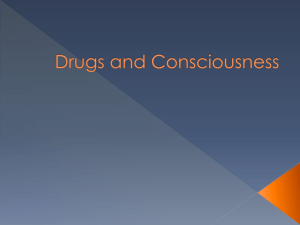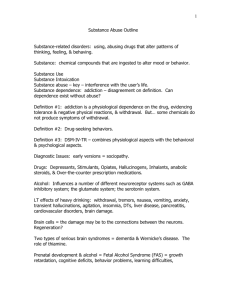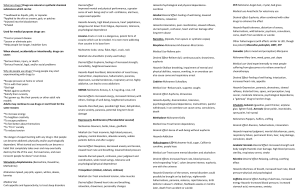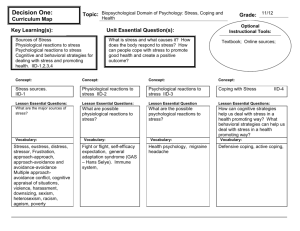Sample
advertisement
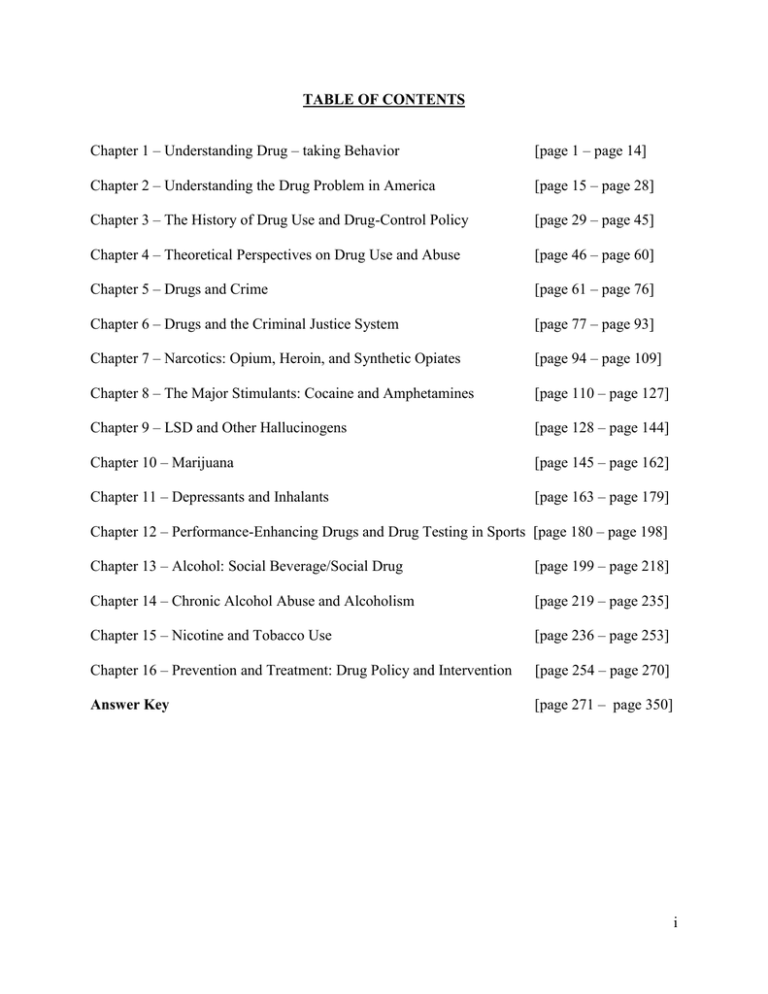
TABLE OF CONTENTS Chapter 1 – Understanding Drug – taking Behavior [page 1 – page 14] Chapter 2 – Understanding the Drug Problem in America [page 15 – page 28] Chapter 3 – The History of Drug Use and Drug-Control Policy [page 29 – page 45] Chapter 4 – Theoretical Perspectives on Drug Use and Abuse [page 46 – page 60] Chapter 5 – Drugs and Crime [page 61 – page 76] Chapter 6 – Drugs and the Criminal Justice System [page 77 – page 93] Chapter 7 – Narcotics: Opium, Heroin, and Synthetic Opiates [page 94 – page 109] Chapter 8 – The Major Stimulants: Cocaine and Amphetamines [page 110 – page 127] Chapter 9 – LSD and Other Hallucinogens [page 128 – page 144] Chapter 10 – Marijuana [page 145 – page 162] Chapter 11 – Depressants and Inhalants [page 163 – page 179] Chapter 12 – Performance-Enhancing Drugs and Drug Testing in Sports [page 180 – page 198] Chapter 13 – Alcohol: Social Beverage/Social Drug [page 199 – page 218] Chapter 14 – Chronic Alcohol Abuse and Alcoholism [page 219 – page 235] Chapter 15 – Nicotine and Tobacco Use [page 236 – page 253] Chapter 16 – Prevention and Treatment: Drug Policy and Intervention [page 254 – page 270] Answer Key [page 271 – page 350] i CHAPTER 1 Understanding Drug-taking Behavior Chapter 1 Multiple Choice Select the correct answer. (Difficulty levels: Basic, Intermediate, Difficult) 1. According to the text, drugs such as alcohol and nicotine are referred to as: a. illegal drugs b. licit drugs c. illicit drugs d. over the counter drugs Answer: b - licit drug Objective: Basic terminology concerning drugs and drug taking behavior Page number: 4 Level: Basic 2. Instances in which a prescription or nonprescription drug is used in an inappropriate way are regarded as: a. illicit drug – taking behavior b. illegal drug use c. drug misuse d. drug abuse Answer: c – drug misuse Objective: Basic terminology concerning drugs and drug taking behavior Page number: 7 Level: Basic 3. William is prescribed a drug from his doctor, and then prescribed a different drug from his dentist. He did not tell either doctor about the other prescription. Unfortunately, when taken together, drug one cancels out drug two, so the secondary drug has no effect. This type of drug effect is: a. sublingual b. subtractive c. synergistic d. biotransformation Answer: c. synergistic Objective: The ways drugs enter and exit the body Page number: 14 Level: Intermediate 4. Which of the following forms of drug administration is the fastest? a. intravenous b. oral c. intramuscular d. sublingual Answer: a - intravenous 2 Objective: The ways drugs enter and exit the body Page number: 10 Level: Basic 5. A transdermal patch works through the principle of what route of administration? a. inhalation b. oral absorption c. absorption through the skin d. absorption through the muscle Answer: c – absorption through the skin Objective: The ways drugs enter and exit the body Page number: 11 Level: Basic 6. What is the most common means of drug elimination through excretion? a. urine b. feces c. saliva d. breath Answer: a – urine Objective: The ways drugs enter and exit the body Page number: 13 Level: Basic 7. The rate of elimination of a particular drug can be determined by an index called: a. the elimination quarter – life b. the elimination rate - life c. the elimination declination life d. the elimination half – life Answer: d - the elimination half – life Objective: The ways drugs enter and exit the body Page number: 13 Level: Intermediate 8. When the combination of two drugs result in an acute effect that is equivalent to the sum of the effects of either drug administered separately, the effect is known as: a. subtractive b. multiplicative c. additive d. obtuse Answer: c – additive Objective: Factors determining the physiological impact of drugs Page number: 14 Level: Intermediate 3 9. If there is a very strong effect when two drugs are taken in combination, even though one of the drugs by itself has no effect and the other by itself has only a weak effect, then what is the combination effect called? a. additive b. subtractive c. synergistic d. potentiation Answer: d - potentiation Objective: Factors determining the physiological impact of drugs Page number: 14 Level: Intermediate 10. The capacity of a drug dose to have a gradually diminished effect on the user as it is taken repeatedly is known as: a. drug interaction b. drug dependence c. drug tolerance d. the placebo effect Answer: c - drug tolerance Objective: Factors determining the physiological impact of drugs Page number: 15 Level: Basic 11. Developing a tolerance for a drug’s effect resulting in tolerance from the effects of another drug never taken is known as: a. cross-reference b. cross-tolerance c. cross-dependence d. cross-induction Answer: b - cross tolerance Objective: The distinction between physical and psychological dependence Page number: 18 Level: Basic 12. A former drug – dependent individual is advised to avoid surroundings associated with his / her drug – taking behavior because it may provoke psychological effects opposite to the drug effect through their association with prior drug taking behavior. This type of tolerance is called: a. psychological tolerance b. behavioral tolerance c. antagonistic tolerance d. drug – dependence tolerance Answer: b. behavioral tolerance Objective: The distinction between physical and psychological dependence Page number: 16 Level: Difficult 4 13. What kind of procedure is conducted when the individual receiving the drug and the person administering the drug are unaware of whether a drug or a placebo is being given? a. blind experiment b. double blind experiment c. administrative experiment d. panacea experiment Answer: b - double blind experiment Objective: The psychiatric definitions of substance abuse and substance dependence Page number: 20 Level: Basic 14. After the metabolic (chemical breakdown) and urinary excretion called biotransformation through enzymes in the liver, what are the end-products of this process called? a. additives b. subtractives c. synergistic carrieres d. metabolites Answer: d - metabolites Objective: Factors determining the physiological impact of drugs Page number: 13 Level: Difficult 15. The distinction between drugs and nondrugs is defined by what intention? a. the intent of the drug use is to induce a bodily or psychological change. b. the intent of the drug use is to cure some ailment. c. the intent of the drug use is accidental d. the intent of the drug use is to Answer: a - the intent of the drug use is to induce a bodily or psychological change. Objective: Basic terminology concerning drugs and drug taking behavior Page number: 5 Level: Intermediate 16. Garrett has taken one substance that has a drug effect of 5, and a second drug with a drug effect of 4. If the combined effect is equivalent to 11, what is the combined drug effect called? a. additive b. hyperadditive c. potentiation d. synergism Answer: b - hyperadditive Objective: Factors determining the physiological impact of drugs Page number: 14 Level: Difficult 5 17. Most of the absorption process is accomplished within how many minutes after ingestion? a. between one and ten minutes b. between two and minutes and three minutes c. between thirty and forty – five minutes d. between five and thirty minutes after ingestion Answer: d - between five and thirty minutes after ingestion Objective: Factors determining the physiological impact of drugs Page number: 9 Level: Basic 18. An interval of time during which the blood levels of a drug are not yet sufficient for a drug effect to be observed is called: a. biotransformation b. latency period c. half – life d. delayed effectiveness. Answer: b - latency period Objective: Factors determining the physiological impact of drugs Page number: 13 Level: Intermediate 19. George has taken a barbiturate for weeks. Unfortunately, he has developed a tolerance to this drug, and also developed a tolerance to another barbiturate that he has never taken. What is this type of reaction called? a. synergistic tolerance b. negated tolerance c. cross tolerance d. double tolerance Answer: c - cross tolerance Objective: Factors determining the physiological impact of drugs Page number: 18 Level: Difficult 20. What is the correct list of routes of administration for drugs? a. oral, injection, inhalation, biotransformation b. oral, injection, inhalation, absorption c. oral, injection, amalgamation, inhalation d. oral, injection, inhalation, immersion Answer: b - oral, injection, inhalation, absorption Objective: Factors determining the physiological impact of drugs Page number: 12 Level: Difficult 6 Chapter 1 True or False Select the appropriate answer, based on whether the statement is true or false. 1. The property of a synergistic drug interaction in which one drug combined with another drug produces an enhanced effect, when one of the drugs alone would have had no effect is called potentiation. a. True b. False Answer: True Objective: Factors determining the physiological impact of drugs Page number: 14 Level: Difficult 2. Regardless of which route of administration is used, the goal is for the drug to be absorbed into the bloodstream. a. True b. False Answer: True Objective: Factors determining the physiological impact of drugs. Page number: 9 Level: Basic 3. Intravenous injection is the fastest type of injection to deliver a drug into the blood. a. True b. False Answer: True Objective: Factors determining the physiological impact of drugs. Page number: 10 Level: Basic 4. Intramuscular injections are often referred to as skin-popping. a. True b. False Answer: False Objective: Factors determining the physiological impact of drugs. Page number: 10 Level: Basic 5. Garrett takes a drug with an effect of 7, and another drug with an effect of 3. If the combined drug effect is 10, then the term for this combination is hyperadditive drug effect. a. True b. False Answer: False - additive Objective: Factors determining the physiological impact of drugs Page number: 14 Level: Difficult 7 6. The elimination half-life of a drug will be faster if the drug is fat-soluble than if it is not. a. True b. False Answer: False Objective: Factors determining the physiological impact of drugs Page number: 13 Level: Intermediate 7. Two examples of hyperadditive combinations are synergism and potentiation. a. True b. False Answer: True Objective: Factors determining the physiological impact of drugs. Page number: 14 Level: Intermediate 8. Potentiation involves the using two drugs; one (when taken alone) has no effect at all. a. True b. False Answer: True Objective: Factors determining the physiological impact of drugs Page number: 14 Level: Basic 9. Placebo is derived from the Latin, “I refuse to comply.” a. True b. False Answer: False – means “I will please” Objective: The psychiatric definitions of substance abuse and substance dependence. Page number: 19 Level: Basic 10. In a double-blind procedure, neither the individual administering the drug or placebo nor the individual receiving the drug or placebo knows which substance is which is being taken. a. True b. False Answer: True Objective: The distinction between physical and psychological dependence. Page number: 20 Level: Intermediate 11. The legislature that established the five drug schedules was the Pure Food and Drug Act. a. True b. False Answer: False - 1970 Comprehensive Drug Abuse Prevention and Control Act 8 Objective: The five-schedule classification of controlled substances. Page number: 24 Level: Intermediate 12. Under the drug schedules established by the US Government, Schedule five (5) lists the most severe, addictive drugs. a. True b. False Answer: False – The 1st schedule is the most severe. Objective: The five-schedule classification of controlled substances Page number: 24 Level: Basic 13. A model of drug dependence based on the idea that the drug abuser is motivated by a craving for the pleasurable effects of the drug is called physiological dependence. a. True b. False Answer: True Objective: The distinction between physical and psychological dependence Page number: 21 Level: Intermediate 14. If the acute effect of one drug is diminished to some degree when administered with another drug, this is called antagonistic. a. True b. False Answer: True Objective: Factors determining the physiological impact of drugs Page number: 14 Level: Basic 15. An injection technique in which a needle is inserted into the tissue underneath the skin is called subcutaneous. a. True b. False Answer: True Objective: Factors determining the physiological impact of drugs Page number: 10 Level: Basic 16. If Rachel consumes drugs from Schedule 1, these are the drugs that have no medicinal purposes at all. a. True b. False Answer: True Objective: The origins and history of drugs and drug-taking behavior 9 Page number: 24 Level: Basic Chapter 1 Fill in the Blank Fill in the appropriate answer. 1. Skin popping is a slang term for __________injection. Answer: Intramuscular Objective: The ways drugs enter and exit the body Page number: 10 Level: Basic 2. The length of the latency period is related to the __________time of the drug. Answer: absorption Objective: Factors determining the physiological impact of drugs Page number: 14 Level: Basic 3 Two examples of hyper-additive combinations are __________and potentiation. Answer: synergism Objective: Factors determining the physiological impact of drugs Page number: 14 Level: Intermediate 4. A phenomenon where chronic use of one drug induces a diminished effect to a second drug that has not been used before is called __________ tolerance. Answer: cross Objective: Factors determining the physiological impact of drugs Page number: 15 Level: Intermediate 5. An injection technique called__________, often called “skin popping” is where a needle is inserted into the tissue just underneath the skin. Answer: subcutaneous Objective: The ways drugs enter and exit the body Page number: 10 Level: Intermediate 6. The sequence of metabolic (chemical breakdown) events leading to urinary excretion begins with a process called __________ chiefly through the action of specific enzymes in the liver. Answer: biotransformation Objective: The ways drugs enter and exit the body Page number: 13 Level: Intermediate 7. The activity of enzymes required for biotransformation may be___________ or 10 __________by the presence of other drugs in the body. Answer: increased or decreased Objective: Factors determining the physiological impact of drugs Page number: 13 Level: Difficult 8. The rate a particular drug exits the body called __________ half-life, is the time it takes for the drug in the bloodstream to decline to 50 percent of its original equilibrium level. Answer: elimination Objective: The ways drugs enter and exit the body Page number: 13 Level: Difficult 9. A former drug – addict is advised to avoid surroundings associated with his / her drug – taking behavior because it may provoke psychological effects opposite to the drug effect through their association with prior drug taking behavior. This is called__________ tolerance. Answer: behavioral tolerance Objective: Factors determining the physiological impact of drugs Page number: 16 Level: Intermediate 10. When administering a drug in a time-release form, a large dose is given initially to enable the drug effect to be felt; then smaller doses are programmed to be released at specific intervals afterward. The intention is to keep the concentration of the drug in the blood within a __________high enough for the drug to be effective while low enough to avoid any toxic effects. Answer: “therapeutic window,” Objective: Factors determining the physiological impact of drugs Page number: 14 Level: Difficult 11. When drugs are administered repeatedly, there is a risk that the 2nd dose will boost the __________of the drug in the blood too high before the effect of the first dose has a chance to decline. Answer: concentration Objective: The ways drugs enter and exit the body Page number: 14 Level: Intermediate 12. The concept of__________ refers to the capacity of a drug dose to have a gradually diminished effect on the user as the drug is taken repeatedly. Answer: tolerance Objective: The psychiatric definitions of substance abuse and substance Page number: 15 Level: Basic 11 13. A__________-_________ procedure is drug research in which neither the individual administering nor the individual receiving a chemical substance knows whether the substance is the drug being evaluated or an active placebo. Answer: double – blind Objective: The psychiatric definitions of substance abuse and substance dependence Page number: 20 Level: Difficult 14. The most important implication of the model of physical dependence, as distinct from psychological dependence, is that individuals involved in drug abuse continue the drug-taking behavior to avoid the feared consequences of__________. Answer: withdrawal Objective: Basic terminology concerning drugs and drug taking behavior Page number: 21 Level: Difficult 15. According to the Controlled Substances Schedules under the Controlled Substance Act, schedule__________ has the highest potential for abuse, and no accepted medical use. Answer: one (1) Objective: The five-schedule classification of controlled substances Page number: 24 Level: Basic 16. Mark, a recovering alcoholic has also developed a tolerance to some barbiturates. Now, Mark is having surgery, and his doctor is concerned about the body needing additional anesthesia when he undergoes surgery soon. This type of reaction is called _________tolerance. Answer: cross Objective: Basic terminology concerning drugs and drug taking behavior Page number: 18 Level: Intermediate 17. Margaret, a heroin user, knows that heroine is detrimental, yet continues to use the drug to avoid severe withdrawal symptoms. She realizes she has developed a __________on heroin. Answer: psychological dependence Objective: The distinction between physical and psychological dependence Page number: 21 Level: Difficult 18. Mark is taking a prescription drug with a drug effect of 4 and another drug with a drug effect of 7. The combination drug effect of the two drugs is equal to 9. This type of reaction is called a (an) ___________ drug effect. Answer: antagonistic Objective: Factors determining the physiological impact of drugs Page number: 14 Level: Difficult 12 Chapter 1 Essay Explain in detail the concepts listed below. 1. Explain the difference between instrumental and recreational drug use. Answer: Based upon on the intent of the individual, drug use can be categorized as either instrumental or recreational. Instrumental use is when a person is taking a drug with a specific socially approved goal in mind. The user may want to stay awake longer, fall asleep more quickly, or recover from an illness. Drug-taking behavior occurs as a means towards an end that has been defined by our society as legitimate. The legal status of the drug itself or whether we agree with the reason for the drug-taking behavior is not the issue here. The instrumental use of drugs can involve prescription and nonprescription (over-the-counter) drugs that are licitly obtained and taken for a particular medical purpose. The instrumental use of drugs also can involve drugs that are illicitly obtained, such as an amphetamine that has been procured through illegal means to help a person stay awake and alert after hours without sleep. Recreational use means that a person is taking the drug not as a means to a socially approved goal but for the purposes of experiencing the effect of the drug itself. The motivation is to experience a pleasurable feeling or achieve a positive state of mind. Whatever happens as a consequence of recreational drug-taking behavior is viewed not as a means to an end but as an end unto itself. Drinking alcohol and smoking tobacco are two examples of licit recreational drug-taking behavior. Involvement with street drugs, in that the goal is to alter one’s mood or state of consciousness, falls into the category of illicit recreational drug-taking behavior Objective: Basic terminology concerning drugs and drug taking behavior Page number: 5 – 7 Level: Basic 2. Explain the difference between licit and illicit drugs. Be sure to include instrumental use and recreational use. Answer: Illicit drugs are drugs whose manufacture, sale, or possession is illegal. Licit drugs are drugs whose manufacture, sale, or possession is legal. Objective: Basic terminology concerning drugs and drug taking behavior Page number: 4 Level: Basic 3. Describe three of the several ways drugs can be administered into the body. Discuss the advantages and disadvantages of each of them with respect to toxicity and side effects. Answer: There are four basic ways to administer drugs into the body: oral administration, injection, inhalation, and absorption through the skin or membranes. Advantages of Oral: Basic consumption. Disadvantages are that the gastrointestinal track sometimes prevents certain drugs from entering that we want absorbed. Advantages of injection: immediate, extreme dosage, and extreme amt of control. Disadvantages are that this type of administration is irreversible. Repeated injections can also cause veins to collapse. Advantages of inhalation: Easiest administration through gas or vapor, concentration of the drug can be precisely controlled. Disadvantages: smoked drugs hazards of breathing particles in the air that contain not only the active drug but also tars and other substances produced by the burning process and throat to the lungs can be become severely irritated over time. Advantages of absorption are: Basic 13 administration such as absorbed through nose membranes, nasal sprays, chewed, or put under tongue to dissolve, suppositories. Disadvantages are irritation of skin or membranes Objective: The ways drugs enter and exit the body Page number: pp. 9-12 Level: Difficult 4. Summarize the Controlled Substances Schedules. Make sure to include their potential for abuse, the potential for medicinal use, and the level of physical and psychological dependence. Also include an example of a drug from each level. Answer: There are five schedules under the Schedules Act. Schedule one has a high potential for abuse, no medical use, and examples would be heroin, LSD, marijuana and PCP. Schedule two has high potential for abuse, and some medical use. Examples would be codeine, morphine, cocaine, and amphetamines. Schedule Three has some potential for abuse, accepted medical use, and example would be barbiturates and narcotic solutions. Schedule four has low potential for abuse, and some examples would be sedative hypnotics and anti-anxiety drugs. Schedule five, the lowest schedule, has minimal potential for abuse, widespread medical use, and prescription cough medicines. Objective: The five-schedule classification of controlled substances Page number: 24 Level: Intermediate 5. Explain at least three criteria that need to be present for substance dependence according to the DSM-IV. Answer: The first criteria is tolerance. The person has to take increasingly large doses of the drug to get the desired effect. Or else the person experiences a diminished effect from the same amount of the drug. The second type of criteria is Withdrawal. When the drug is stopped, there are psychological or physiological withdrawal symptoms or else the substance is taken to relieve or avoid these symptoms. The third criteria selected is persistent desire or efforts to control drug use. The person tries to quit and repeatedly relapses into further drug use. Objective: The distinction between physical and psychological dependence Page number: 23 Level: Difficult Chapter 1 Matching Match the correct terminology in the left column to the definition in the right column. 1. elimination a. Referring to the motivation of a drug user who takes a drug only to get half-life “high” or achieve some pleasurable effect. 2. drug tolerance b. The combination of two drugs that results in an acute effect that is equivalent to the sum of the effects of either drug administered separately. 3. drug misuse c. The capacity of a drug dose to have a gradually diminished effect on the user as it is taken repeatedly. 4. additive d. Instances in which a prescription or nonprescription drug is used in an inappropriate way. 5. drug e. A condition in which an individual feels a compulsive need to continue 14 dependence 6. instrumental use 7. recreational use 8. crosstolerance taking a drug. f. Referring to the motivation of a drug user who takes a drug for a specific purpose other than getting “high.” g. The length of time it takes for a drug to be reduced to 50 percent of its equilibrium level in the bloodstream, which is a product of biotransformation. h. A phenomenon in which the tolerance that results from the chronic use of one drug induces a tolerance effect with regard to a second drug that has not been used before. 1. *[g] Objective: The ways drugs enter and exit the body Page: pg 13 2. *[c] Objective: The distinction between physical and psychological dependence Page: 15 3. *[d] Objective: Basic terminology concerning drugs and drug taking behavior Page: 7 4. *[b] Objective: Basic terminology concerning drugs and drug taking behavior Page: 13 5. *[e] Objective: Basic terminology concerning drugs and drug taking behavior Page: 4 6. *[f] Objective: Basic terminology concerning drugs and drug taking behavior Page 6 7. * [a] Objective: Basic terminology concerning drugs and drug taking behavior Page 7 8. * [h] Objective: Basic terminology concerning drugs and drug taking behavior Page 18 15

